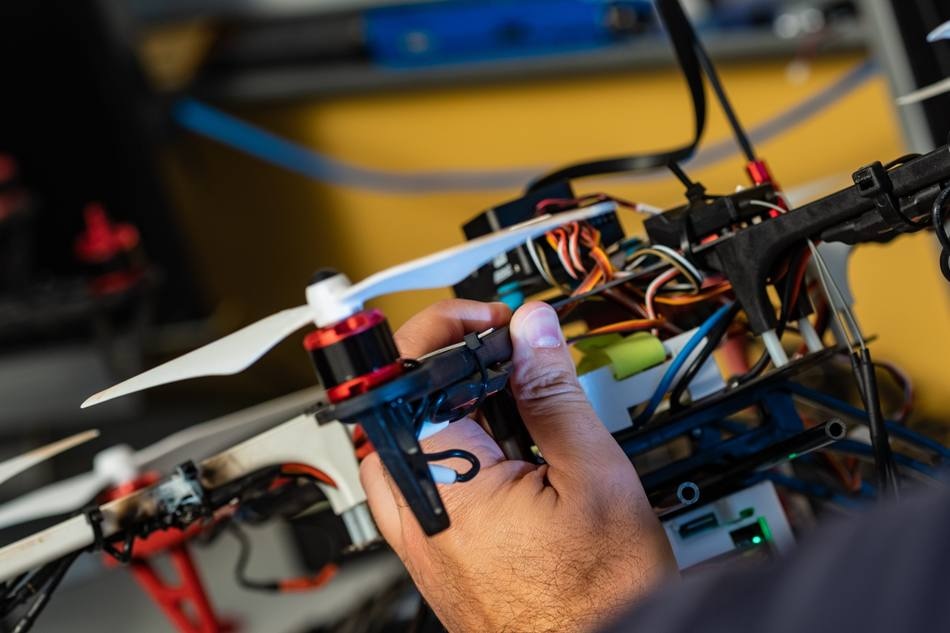Aug 29 2018
Scientists from the Rice University, in a partnership with Baylor College of Medicine and Houston nonprofit Technology For All (TFA), are creating a fleet of autonomous aerial drones that coordinate with each other to detect, track, and model the environment and make neighborhoods be aware of airborne hazards that can be particularly risky after extreme weather events.
 Rice University postdoctoral researcher Riccardo Petrolo holds an autonomous drone set up to find and model dangerous pollutants. Photo by Jeff Fitlow
Rice University postdoctoral researcher Riccardo Petrolo holds an autonomous drone set up to find and model dangerous pollutants. Photo by Jeff Fitlow
Rice electrical and computer engineer Edward Knightly and his collaborators have won a National Science Foundation grant for $1.5 million to enable ASTRO, an aerial system to collect real-time, high-resolution data regarding volatile organic compounds (VOCs) discharged into the atmosphere by way of explosions, leaks, or other accidents.
Early prototypes of the networked drones were showcased by Rice students who developed software protocols as their capstone design project at the Oshman Engineering Design Kitchen earlier this year. That project won the award for best gaming, creative, robotics or innovative technology award at the annual George R. Brown Engineering Design Showcase.
The new grant will allow the project team to not only pursue developing next-generation wireless and sensing technologies but also to ultimately deploy them in at-risk locations.
“Now, if there’s a chemical leak, people may not learn about it for a couple of days, but our system can inform them immediately through their mobile phones,” said Riccardo Petrolo, a postdoctoral researcher in Knightly’s lab. “We are also concerned about the dangers first responders might face during extreme events like Hurricane Harvey. We want them to know where the edge of a plume is located so they know where it’s safe to breathe and where to set evacuation boundaries.”
When correctly rigged, several ASTRO drones will assemble a 3D record of aerial pollution using advanced modeling methods put together by Rice environmental engineering professor Rob Griffin. The scientists hope to deploy ASTRO for testing in a neighborhood close to the Houston Ship Channel, home to industrial processing plants and chemical refineries. Cliff Dacso, a professor of molecular and cell biology at Baylor, will direct the team’s analysis to concentrate on VOC signatures that are most harmful to human health.
That community, on Houston’s east side, is already being served by Rice engineers who partnered with TFA to deploy a sophisticated Wi-Fi network in 2011. Along with Will Reed, TFA president and project team member, the scientists would like to take advantage of that connection so drones can provide information regarding air quality to residents of the neighborhood in real time.
The team has already created a prototype ASTRO mobile app to alert community residents to dangerous VOC concentrations.
ASTRO’s exclusive abilities will allow the system to function without the involvement of a person or a ground controller. Yingyan Lin, a Rice professor of electrical and computer engineering, is formulating custom machine-learning techniques for the project. “We might need someone in a car to pick them up, or they might have a base station on the ground, but day to day, they should be able to take off, track plumes and send that information back through the internet,” Petrolo said.
Drones will contain on-board sensors and transmitters that coordinate among themselves to locate and track the plumes. Petrolo said Rice engineering colleagues led by laser pioneer and emeritus professor Frank Tittel are working to minimize the size of the sensors.
Petrolo stated ASTRO’s capabilities will go beyond gas sensing. “The platform is fully agnostic,” he said. “There’s no reason it can’t support cameras and other wireless sensors to, for instance, find someone in an emergency response situation.”
Petrolo said the technology will permit the use of as few or as many drones as required to achieve a task.
Rice University students develop flying platform for sophisticated sensing applications
A video produced in April described the award-winning work by Rice University students to create software for an autonomous drone platform. The technology has won backing by the National Science Foundation for further development. (Credit: Brandon Martin/Rice University)